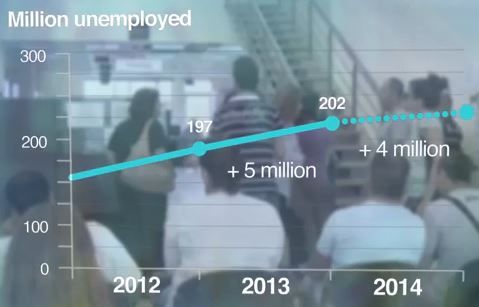Global unemployment rose by five million in 2013 to nearly 202 million, according to the International Labor Organization (ILO), part of the United Nations.
The ILO says that the worldwide labor force is growing more rapidly than employment growth. Most of the rise in unemployment is in the South Asia and East Asia regions, which together represent over 45% of the extra people looking for work, followed by Europe and Sub-Saharan Africa.
In Latin America, however, only 50,000 more people were added to the unemployment total, representing less than 1% of the global increase.
In an online communique, the ILO writes:
“Overall, the crisis-related global jobs gap that has opened up since the beginning of the financial crisis in 2008, over and above an already large number of jobseekers, continues to widen.”
Last year the gap reached 62 million jobs, including 32 million more people looking for work, 23 million adults who gave up looking and are no longer seeking employment, and seven million economically inactive people who prefer to stay out of the job market.
If the current trend persists, the ILO predicts there will be 215 million unemployed people worldwide by 2018. Over the next four years there will be 42.6 additional people entering the jobs market each year but only 40 million net new jobs.
Four million more unemployed expected this year (Source: ILO).
Young people and unemployment
Young people are affected more than the rest of the potentially active population by this fragile and uneven economic recovery. The ILO estimates that approximately 74.5 million people aged 15 to 24 years were unemployed last year, nearly one million more than in 2012.
The world has a youth unemployment rate today of 13.1%, nearly three times as high as the adult rate. “Indeed, the youth-to-adult unemployment ratio has reached a historical peak. It is particularly high in the Middle East and North Africa, as well as in parts of Latin America and the Caribbean and Southern Europe,” the ILO writes.
In countries where data exists, the percentage of young people neither in employment nor in education or training (NEET) has increased significantly since the start of the financial crisis. In some parts of the world 1 in every 4 people aged 15 to 29 is currently NEET.
Youth unemployment is a growing global problem (Source: ILO).
Longer unemployment spells today
With the current weak recovery, how long people stay unemployed has lengthened significantly, a further sign of inadequate job creation. In the majority of developed nations people have been unemployed twice as long as their counterparts before the financial crisis.
In the peripheral nations of the Eurozone, the average Greek unemployed person spends about 9 months without work; in Spain the period is 8 months. Even in countries where the recovery is stronger, such as the US, forty percent of all job seekers are long-term unemployed people.
Long periods of unemployment undermine labor market recovery, even when the economy starts to gather steam. Not only do they constitute a considerable burden for the public purse, workers lose their skills and find it progressively harder to find a job.
The number of working poor continues to fall
Although at a slower rate than before the financial crisis, the number of working poor is declining worldwide.
Last year 375 million workers (11.9% of all workers) globally earned less than $1.25 per day, and 839 million (26.7%) lived on less than $2 per day, compared to 600 million and 1.1 billion respectively in the early 2000s.
However, the rate of decline has stalled, last year the number of employees in extreme poverty fell by just 2.7% worldwide, the lowest fall in more than ten years.


